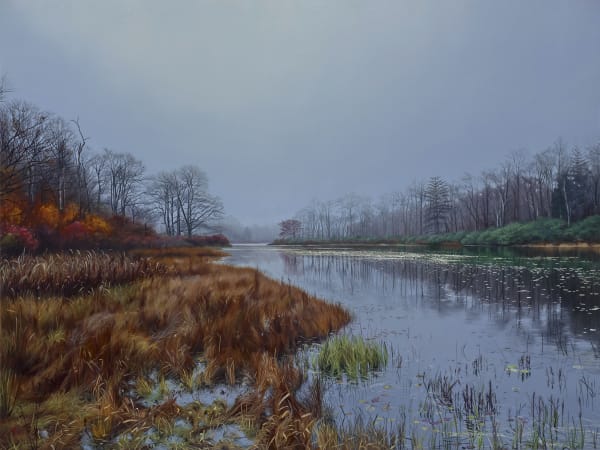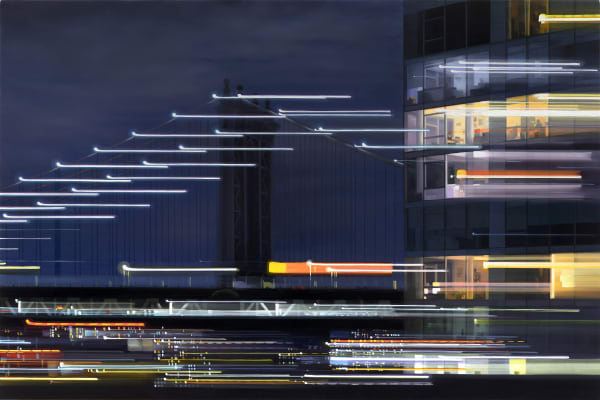Flying High: Alexandra Pacula's Paintings at Gallery Henoch
It's Shimmering Twilight, 2023, and there's New York, seen from above, the Chrysler Building front and center, all lit up, dazzling in the surrounding darkness, modified by the surrounding buildings, some with rows of illuminated floors, many with blacked out windows, in the distance New Jersey, with an array of luminous and darkened buildings. Beyond it, in the infinite distance, is a blue sky, beginning to darken, and between Manhattan and New Jersey is the Hudson River, its water a darkening blue. The trafficked streets on either side of the Chrysler building are streaks of radiant light, yellow in contrast to the white light that informs and emanates from the Chrysler Building. The painting is a masterpiece of geometrical abstraction and magic realism, Franz Roh's term for modern realist paintings that had a dream-like look and sometimes fantastic content. The Chrysler Building is real, but all lit-up it looks fantastic, peculiarly unreal, a bright ghost in a Hadean Manhattan, as the black buildings that surround it suggest. They're high but not as high, nor as beautiful and regal as the art deco crown that it wears makes it. In the distance to its right, and almost as high as it, an anonymous black skyscraper rises, signaling the demise of beauty in New York. Some windows are lit, sometimes rows of illuminated windows wrap around a building, announcing an isolated, deserted floor. It is hard to do descriptive justice to Pacula's ingenious painting, hovering on the borderline between descriptive realism and pure abstraction-they seem dialectically interchangeable and ingeniously merged-but they are clearly aesthetic masterpieces.
The Chrysler Building appears again in Distant Glow, 2023, its art deco crown now a luminous blur mounted by a thin black antenna. The building is pitch black, with some luminous gestural streaks, some sky blue, some faded yellow, a few white. They're all more or less the same size, animating the corpse-like building without bringing it to life. It is framed by pitch black buildings, one with similar gestures dripping down its sides. They open the way to the building, framing it like guardians to its mysterious presence. Now and then a realistic detail appears on the top of the abstract buildings. They all emerge from and rest on a hellish red plane seemingly flatter, certainly more anonymous, than they are. Thin, diluted, atmospheric shadow haunts its top, perhaps fancifully suggesting it is the gate to hell, for it is divided in the center, suggesting it is two closed doors. Small white gestures proliferate at the base, along with what look like lit candles-but they're token figures on the streets below the skyscrapers, their abstractness signaling the anonymity of the city, not to say the smallness of people in the big city. In New York real estate is more important than people.
Pacula's paintings may be magically realistic, an ingenious fusion of realism and abstraction, but they are, however subliminally, socially critical, as the token appearance of a figure in a window in an office building in Evening Rhapsody, 2023 suggests. The figure is anonymous and faceless, unlike the figures in Hopper's Nighthawks, 1942, forming a small "lonely crowd," as the sociologist David Riesman called it. In contrast Pacula's late night office worker may prefer being alone, having little or no interest in working with others. Pacula is a psychological realist, whether she knows it or not. The empty rooms in Inside The Grid I, 2023, suggests she knows it. Loneliness, the sense of being socially isolated, has become epidemic in the United States, as the Surgeon General Report "Our Epidemic of Loneliness and Isolation," published on May 3, 2023, makes clear. "They can increase the risk of premature death by more than 60%." The isolated figures in the rooms pictured in Inside The Grid II, 2023, mechanically going about their tasks, epitomize what the psychiatrist Jacqueline Olds calls "the loneliness in everyday American life." Pacula's paintings are sublimely beautiful abstractions, refined to aesthetic perfection, but they are also peculiarly pessimistic, for they picture a dehumanized city, in which big buildings are more important than little people, in which skyscrapers are more important than people on the ground. Alfred Kazin was A Walker In The City, but there are no sidewalks in Pacula's New York. It is a lightning blaze of colors as the parallel horizontal lines of colors in Vibrant City, 2022 and the parallel vertical lines of color in Rapid Rise, 2022 make clear. She is a master of Linear Movement I and II, both 2021, and of color movement-not to say emotionally moving color-as Chrysler Zoom and Empire Zoom, both 2022 make clear-works that confirm that she seems to prefer big buildings to little people like those in their offices, oddly coffin-like. I suggest that in Digital, 2019 she gets the anonymous, mechanical, inhuman essence of the city, a city that epitomizes what the sociologist T. W. Adorno calls "the indifference that is everywhere" in modern society. Pacula's urban abstractions are aesthetically brilliant but her buildings, however grand, are bleak and hollow and inhuman at the core, as her grid works make clear. She has made the office building skyscraper-supposedly the monumental epitome of what Le Corbusier called a "machine for living"-into a machine for dying from the modern disease of loneliness. Her skyscrapers are in emotional effect glorified mausoleums.
Where does she go when she is not dancing to New York's Electric Beat, 2023 or on one of its Electric Trails, 2022 or high In Flight, 2022 in an airplane heading towards it? She goes to the Promised Land, 2023 that is untouched nature. She escapes the exciting, nerve-racking city-for her colorful lines, relentlessly moving, seem like raw nerves--to re-create herself in the quiet of the wilderness. She is a great landscape painter, conveying its innocent sublimity and quiet eloquence, as Mountain Lake, 2021 makes clear. She gets up close and intimate with it as Spring Thaw, 2020 shows, to the extent of treasuring its remarkable growths, as Mushroom I and II, both 2020 show. She paints them with contemplative calm, leaving the headlong energy that informs her skyscrapers. Pacula's nature representations are as meticulously detailed and exquisitely executed as her urban abstractions. They're calm and collected, tranquil rather than excited, almost with manic energy, as her abstractions are. Pacula is a masterful painter, ingeniously confirming Kandinsky's assertion that there are "many possible combinations of the abstract and the real," a "welcome combination" that makes for a "musical art"-like Kandinsky she plays the color keys knowledgably and rhapsodically-and with that a "spiritual art," certainly a high-spirited art.
A spiritual art affords what the psychologist Abraham Maslow calls a "peak experience"-a transcendental experience, which is why I am tempted to call Pacula a "transcendental realist." So-called "transcendental abstraction" dispensed with observed reality, finding-experiencing-transcendence in and through color, line, and form alone, so-called pure art, indicating it is a form of what might be called aesthetic mysticism, as Robert Motherwell insisted. It assumes there is a discontinuity between "extraordinary" aesthetic experience and "ordinary" everyday experience. In contrast, the philosopher John Dewey argues that any experience can become an aesthetic experience, that is, a heightened state of awareness, in which different, even contradictory features of everyday reality, spontaneously converge in an act of what the philosopher Jacques Maritain calls creative intuition. A peak experience, according to Maslow, is a "rare, exciting, oceanic, deeply moving, exhilarating, elevating experience that generates an advanced form of perceiving reality." It is an intense, often ecstatic experience, a dynamic rather than static experience, often bringing with it a sense of elation, rapture, as Pacula's euphoric abstractions suggest. Her paintings embody the energy of the city, even as her office buildings embody its delusion of grandeur, and with that its peculiar dehumanizing effect, for measured against her skyscrapers human beings are inconsequential, as the office workers trapped in the grid are. Pacula is a social realist as well as a transcendental realist. WM





